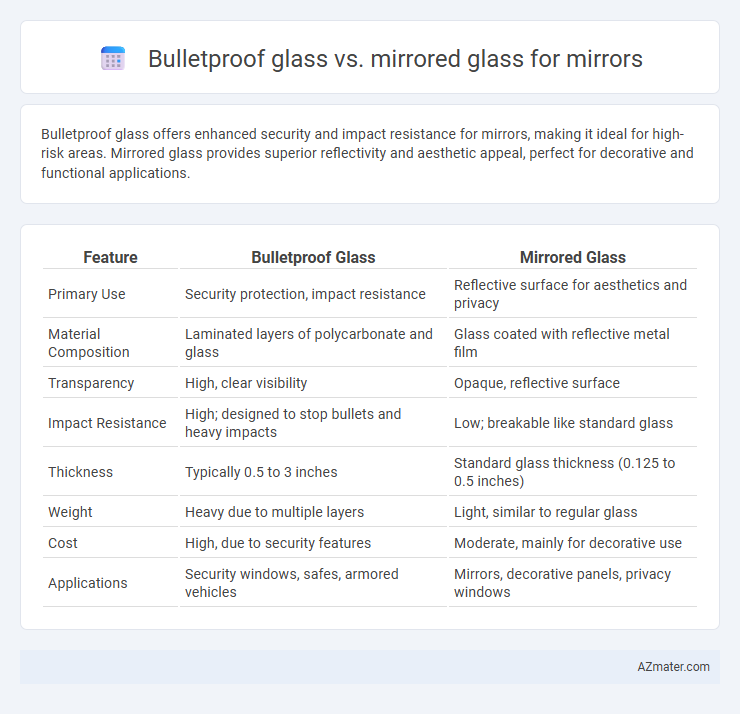Bulletproof glass offers enhanced security and impact resistance for mirrors, making it ideal for high-risk areas. Mirrored glass provides superior reflectivity and aesthetic appeal, perfect for decorative and functional applications.
Table of Comparison
| Feature | Bulletproof Glass | Mirrored Glass |
|---|---|---|
| Primary Use | Security protection, impact resistance | Reflective surface for aesthetics and privacy |
| Material Composition | Laminated layers of polycarbonate and glass | Glass coated with reflective metal film |
| Transparency | High, clear visibility | Opaque, reflective surface |
| Impact Resistance | High; designed to stop bullets and heavy impacts | Low; breakable like standard glass |
| Thickness | Typically 0.5 to 3 inches | Standard glass thickness (0.125 to 0.5 inches) |
| Weight | Heavy due to multiple layers | Light, similar to regular glass |
| Cost | High, due to security features | Moderate, mainly for decorative use |
| Applications | Security windows, safes, armored vehicles | Mirrors, decorative panels, privacy windows |
Introduction: Bulletproof Glass vs Mirrored Glass
Bulletproof glass provides enhanced security with multiple layers of laminated glass designed to resist impact and penetration, making it ideal for applications requiring safety and protection. Mirrored glass offers reflective properties that enhance privacy and aesthetic appeal by creating a one-way mirror effect, commonly used in decorative and surveillance settings. Both materials serve distinct purposes, with bulletproof glass prioritizing durability and mirrored glass emphasizing visibility control.
Understanding Bulletproof Glass: Properties and Applications
Bulletproof glass is a laminate of multiple layers of glass and polycarbonate materials designed to resist high-impact forces and ballistic threats, making it ideal for security applications such as bank teller windows, armored vehicles, and secure facilities. Its unique composition absorbs and distributes impact energy, preventing penetration and maintaining clarity, unlike mirrored glass, which primarily serves aesthetic and privacy purposes without offering ballistic protection. The advanced engineering of bulletproof glass balances transparency with strength, enabling safe visibility in environments requiring enhanced security.
Mirrored Glass Explained: Features and Uses
Mirrored glass features a reflective coating applied to one side, creating a smooth, polished surface that enhances privacy and aesthetics by reflecting light and images. It is commonly used in architectural applications, interior design, and decorative mirrors to provide a sleek appearance while allowing natural light to pass through when viewed from the uncoated side. Unlike bulletproof glass, which prioritizes impact resistance and safety, mirrored glass focuses on creating visual effects and functional privacy without the need for heavy reinforcement.
Key Differences Between Bulletproof and Mirrored Glass
Bulletproof glass consists of multiple layers of laminated glass and polycarbonate, providing high impact resistance and protection against ballistic threats, while mirrored glass is a single reflective surface primarily used for aesthetic or privacy purposes without protective qualities. Bulletproof glass typically weighs more and is significantly thicker than mirrored glass, which is lightweight and designed to reflect light or create one-way visibility. The main functional difference lies in bulletproof glass's ability to stop or slow projectiles, contrasted with mirrored glass's emphasis on visibility control and decorative use.
Safety and Security: Which Glass Offers Better Protection?
Bulletproof glass provides superior protection with its multi-layered construction designed to absorb and disperse impact energy, making it highly resistant to forced entry and ballistic threats. Mirrored glass, while reflective and offering some privacy, lacks the structural strength to withstand impacts or break-ins, posing a lower level of security. For maximum safety and security in mirrors, bulletproof glass is the optimal choice due to its enhanced durability and impact resistance.
Aesthetic Considerations: Visual Impact on Mirrors
Bulletproof glass enhances mirrors by providing a clear, durable surface with minimal distortion, preserving sharp reflections while ensuring safety. Mirrored glass offers a sleek, reflective finish that can incorporate various tints and coatings, creating striking visual effects suited for modern and decorative designs. The choice between bulletproof and mirrored glass depends on balancing aesthetic clarity with protection requirements in interior or exterior mirror applications.
Installation Challenges and Requirements
Bulletproof glass installation demands precise framing and structural reinforcement due to its significant weight and thickness, requiring specialized hardware to ensure secure mounting and safety compliance. Mirrored glass, while lighter and easier to handle, necessitates careful sealing and alignment to prevent distortion and maintain reflective quality, often needing professional-grade adhesives or mechanical fixes. Both types require expert assessment of wall support and environmental factors to avoid stress fractures or detachment, but bulletproof glass often involves higher costs and longer installation times due to its complex handling requirements.
Maintenance and Durability Comparison
Bulletproof glass offers superior durability compared to mirrored glass, resisting impacts, scratches, and weathering to maintain clarity over time. Mirrored glass, while aesthetically appealing, typically requires more frequent maintenance to prevent tarnishing, scratches, and loss of reflective quality. The higher maintenance demand of mirrored glass contrasts with the low upkeep and long-lasting strength of bulletproof glass, making the latter ideal for high-traffic or security-sensitive mirror applications.
Cost Analysis: Bulletproof Glass vs Mirrored Glass
Bulletproof glass generally incurs higher costs than mirrored glass due to its multi-layered construction using polycarbonate and laminated glass designed to resist impact and penetration. Mirrored glass, being primarily a reflective surface coated with a thin metal layer, is more affordable and easier to manufacture, making it cost-effective for decorative applications. Budget considerations often weigh heavily towards mirrored glass unless the enhanced security and durability of bulletproof glass justify the additional investment.
Choosing the Right Glass Type for Your Mirror
Bulletproof glass offers enhanced security and impact resistance, making it ideal for mirrors in high-traffic or vulnerable areas where safety is a priority. Mirrored glass provides superior reflective clarity and aesthetic appeal, perfect for decorative or design-focused applications where visual quality is essential. Selecting the right glass type depends on balancing durability needs with the desired visual effect, ensuring both functionality and style in your mirror installation.

Infographic: Bulletproof glass vs Mirrored glass for Mirror
 azmater.com
azmater.com